Eating with your hands is the norm in parts of Asia, Africa, and the Middle East
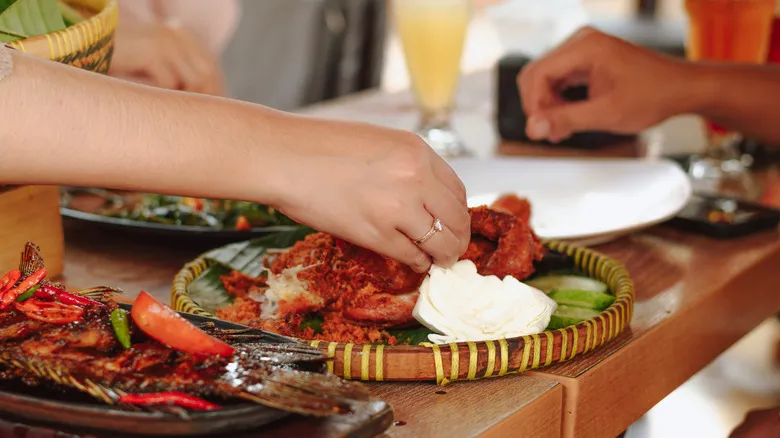
Forks, spoons, and knives are fundamental utensils for most meals in Western nations, except for foods that can be eaten with your hands, such as sandwiches and pizza. In contrast, many regions around the globe, including South Asia, Africa, and the Middle East, commonly practice eating with their hands. Some cultures utilize bread as a substitute for cutlery, while others simply use their hands to gather bites of food. Many individuals feel that eating with their hands fosters a deeper connection to their meal and enhances the flavor when food is consumed directly from hand to mouth.
In many countries where hand-eating is customary, there are specific etiquette guidelines to observe. Firstly, it is essential to wash your hands before dining. In numerous cultures, only the right hand is permitted to touch food, as the left hand is often deemed unclean and associated with personal hygiene tasks. To pick up food, it is advisable to use your first three fingers to gather and pinch a bite-sized piece. If you have bread or rice, you can use it to scoop or support your portion. Lastly, instead of inserting your fingers fully into your mouth, use your thumb to guide the food in.
The customer is not always right in France
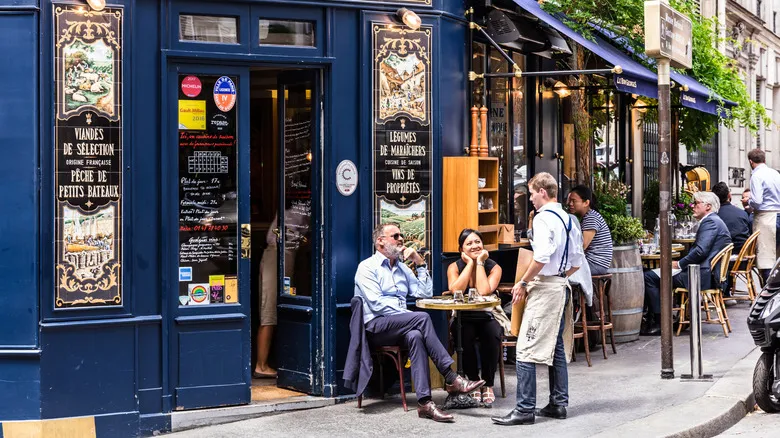
France is often recognized as the origin of the modern restaurant, which fosters a profound appreciation for dining as an art rather than merely a transaction. In contrast to North America, where the adage "the customer is always right" prevails, French dining establishments embrace a different philosophy. Here, chefs and servers are skilled professionals who take immense pride in their craft and expect to be treated with the same respect they extend to their patrons. Being excessively demanding or rushing through a meal may not be received as graciously as it might elsewhere.
In France, the experience of dining out centers on savoring the food, the ambiance, and the skill that goes into each dish. Chefs meticulously design their menus, drawing from tradition, vision, and technique. As a result, requesting modifications or substitutions may be viewed unfavorably, as would returning a dish without a legitimate reason. Additionally, meals are intended to be enjoyed at a relaxed pace, so it’s unlikely that your server will linger at your table. When it comes to settling the bill, it is considered impolite for the server to present it without being asked, so you will need to request it explicitly.
Elder people eat first in Korea
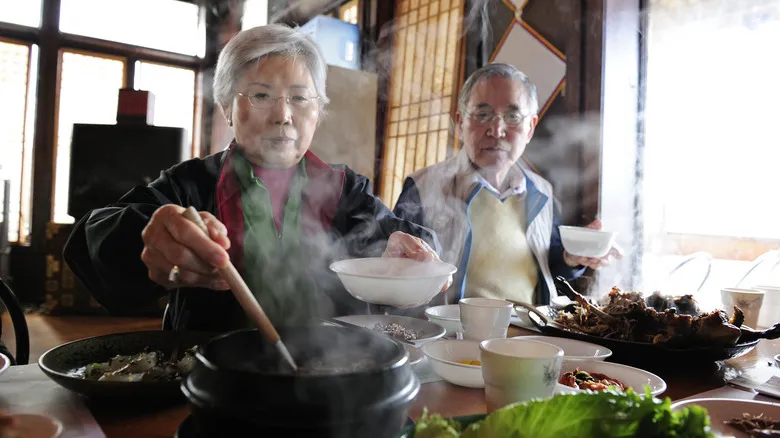
If you've ever eaten at a Korean restaurant, you may have noticed that the experience is often communal. Families, friends, and colleagues come together around the table to share a variety of dishes, ranging from small side dishes known as banchan to hot pots and Korean barbecue. Given the communal aspect of the meal, it's essential to be mindful of your table manners to avoid offending your dining companions. One of the primary rules of Korean dining etiquette is that elders begin the meal.
Respect for elders is a fundamental value in many Asian cultures, and Korea is no different. When dining out, it's courteous to allow older or higher-ranking individuals to take their seats first. Once everyone is seated, it is customary for the most senior person to pour the first round of drinks. Be sure to accept the drink offered to you, as declining it is seen as impolite. When the food is served, it is respectful to wait for the senior members to start eating before you begin your own meal. Once they have taken their first bite, you can enjoy your food.
Ordering milky coffee drinks after 11 a.m. is odd in Italy

Italians have a deep appreciation for their coffee and adhere to certain unspoken customs regarding when and how it should be enjoyed. One thing to consider before ordering at an Italian café or restaurant is the timing of milky coffee drinks. Many Italians view cappuccinos and caffé lattes as suitable breakfast options, but too heavy for later in the day. After lunch, espressos are the preferred choice.
While there's nothing wrong with ordering a milky coffee after lunchtime, be prepared for some curious glances from your barista. Familiarizing yourself with some Italian coffee terminology can also be beneficial. For instance, "latte" simply means milk in Italian, so if you order a latte, that's what you'll receive. The proper name for a drink made with espresso and steamed milk topped with a light layer of foam is a caffé latte. Other acceptable coffee options after noon include a macchiato, which consists of espresso with a small amount of steamed milk, and a caffé corretto, which features espresso with a splash of liquor.
Sweets are served at the beginning of the meal in Uzbekistan
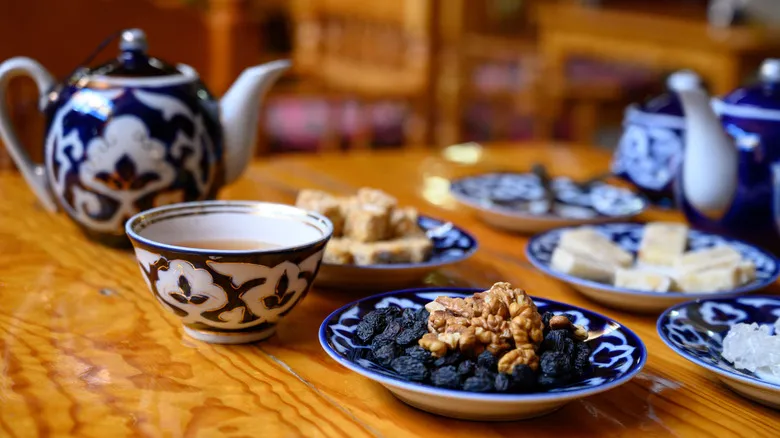
If you enjoy beginning your dining experience with something sweet, Uzbekistan is the perfect destination for you. Here, many meals kick off with an array of delightful treats, including dried fruits and candied nuts. You may also encounter traditional confections like parvarda caramels and halva, which resembles fudge and often includes seeds or nuts. These sweets are typically accompanied by black or green tea before the main course.
While you might be tempted to indulge in these delicious dessert-like offerings, it's wise to save some appetite for the substantial main dishes that Uzbekistan has to offer. The national dish, plov, is a flavorful rice pilaf made with meat—traditionally lamb—and a mix of vegetables like onions and carrots. Another filling option is laghman, which features hand-pulled noodles served with meat and vegetables. Your meal may also include a refreshing salad of cucumbers, tomatoes, and onions. And of course, no meal in Uzbekistan is complete without bread.
It's taboo to clink beer glasses in Hungary

In various beer-drinking cultures worldwide, clinking glasses is a popular way to celebrate. However, if you try this in Hungary, you might receive some disapproving looks. The prohibition against toasting with beer has its roots in the mid-1800s, during the time when Hungarian rebels were striving for independence from the monarchy. After the Austrians suppressed the revolution in 1849 and executed several Hungarian soldiers, it is said that they celebrated by clinking beer glasses. In retaliation, the Hungarians pledged to refrain from toasting with beer for 150 years.
Although the Hungarian prohibition on clinking beer glasses officially ended in 1999, many older individuals still avoid this practice out of tradition. Younger generations, however, tend to be less concerned about it. That said, if you want to steer clear of offending anyone, it might be wise to skip the gesture entirely. The good news is that clinking glasses with other drinks is perfectly acceptable. You can raise a toast with wine or enjoy a celebratory clink with popular Hungarian beverages like pálinka (a fruit brandy) or unicum (a herbal bitter liqueur).
Sticking chopsticks upright in a bowl is disrespectful in many Asian countries
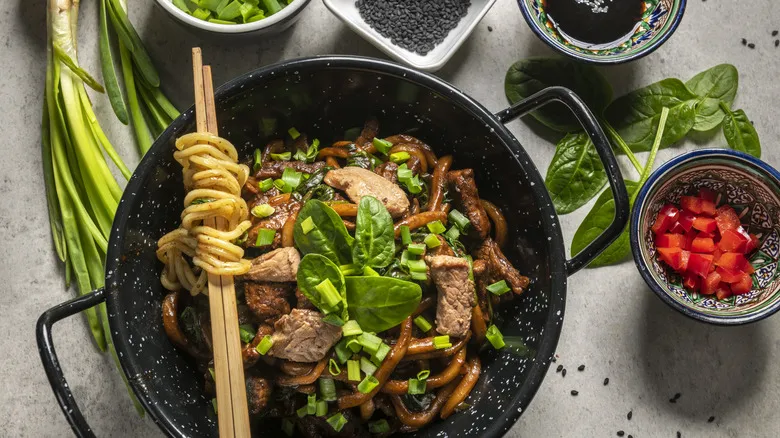
Do you already know how to use chopsticks? If so, you might think that dining out in Asia will be easy. However, it's important to understand that some Asian cultures have specific etiquette regarding chopsticks that goes beyond just using them for eating. In countries like China, Japan, and Vietnam, it is considered impolite to stick your chopsticks upright in your bowl of food, as this resembles the incense used in bowls during funerals and memorial ceremonies.
The correct way to place your chopsticks when you're not using them is to lay them flat on your plate or bowl. If available, using a wooden or plastic chopstick holder is even better. Other common chopstick mistakes include pointing at people with your chopsticks, tapping objects, and transferring food from one pair of chopsticks to another. When dining with shared dishes, it's also essential to take only the food that your chopsticks have touched.
Feeding people by hand is a sign of respect in Ethiopia

Ethiopia is one of the many nations worldwide where meals are often shared communally, and eating with your hands is customary. When you dine at an Ethiopian restaurant, you'll likely be served a large platter known as a gebeta, featuring a variety of dishes such as stews, salads, and grains. Accompanying these dishes will be injera, a flatbread used to scoop up your food. Don’t be surprised if one of your fellow diners pinches some food with a piece of injera and offers to feed it to you by hand.
This act of feeding others in Ethiopia is referred to as "gursha," and it signifies affection, generosity, and respect. The proper way to perform this gesture is to tear off a piece of injera, use it to scoop a bite-sized portion of food, and then offer it to your dining companion, gently placing it in their mouth. Accepting the food is considered polite, as it represents trust and fosters a sense of connection. It’s also good etiquette to reciprocate by offering a gursha back to the person who fed you.
Leaving empty bottles on the table is considered bad luck in Russia

You can't experience Russia without enjoying a meal accompanied by vodka. It's customary to have a bottle on the table alongside a variety of tapas-style dishes known as zakuski, which may feature pickled vegetables, smoked fish, and Olivier potato salad. Vodka can also complement the main course, typically served in small glasses. After a toast is made, it's customary to down your drink in one go. Importantly, all empty bottles must be cleared from the table to avoid attracting bad luck.
The origins of the Russian superstition regarding empty bottles on the table are unclear. Some believe it stems from a pagan notion that evil spirits are drawn to vacant containers. Others trace it back to the Napoleonic Wars when bars in Paris charged patrons based on the number of empty bottles on their tables. Russian soldiers in Paris would discreetly slide the bottles under the table to reduce their tab. Regardless of its origins, this tradition serves as an effective way to declutter the table and signal to your server that you're ready for a fresh bottle.
Tipping isn't expected at restaurants in Japan

In many countries, leaving a tip at a restaurant or bar is a common practice, but in Japan, it is not required and may even be considered impolite. Japanese hospitality focuses on delivering exceptional service without the expectation of gratuity. In fact, staff may go out of their way to return any extra money you leave, which can interrupt the flow of service.
When settling your bill at a restaurant in Japan, you typically take your check to a cashier station to make your payment and keep the change. If you wish to express gratitude for the service, a simple "arigato gozaimasu" accompanied by a slight bow is appreciated. This applies to other service providers as well, such as taxi drivers and hotel staff. The only exceptions are upscale ryokans, where it is acceptable to leave a cash tip in an envelope for your attendant, as well as for private tour guides or interpreters.
Port should always be passed to the left in the U.K.

Port makes for an ideal after-dinner indulgence. This fortified red wine is usually characterized by its fruity flavors, complemented by hints of caramel and spice. In the U.K., it is commonly enjoyed alongside rich dishes such as chocolate or cheese. There is also a notable tradition regarding the serving of port: the decanter should always be passed to the left. This custom is believed to have originated with Royal Navy officers who needed to keep their right "sword arms" unobstructed.
Additionally, there are a few more customs associated with serving port in the U.K. Firstly, the decanter should be positioned on the table to the right of the host. The port is then circulated around the table to the left in a clockwise manner until it returns to the host. If the port lingers too long with one individual, it is customary for others to inquire, "Do you know the Bishop of Norwich?" According to legend, an elderly bishop from Norwich was known for dozing off at the table, inadvertently halting the flow of port.
Flipping a whole fish is considered bad luck in China
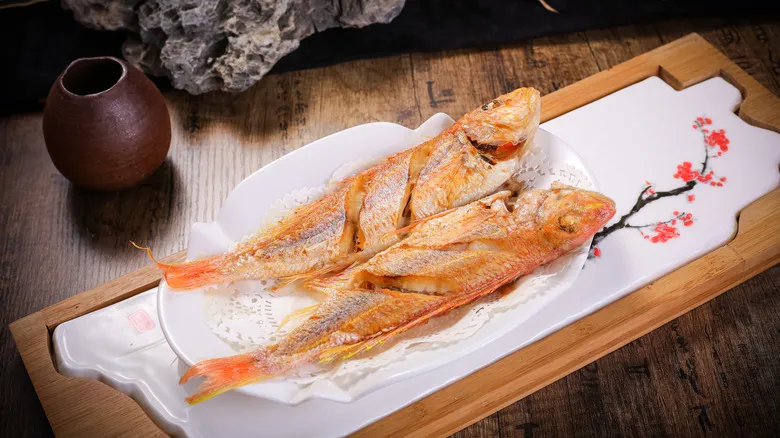
In China, numerous dishes hold special meaning as they symbolize good luck and abundance. One such dish is whole fish, commonly served during holidays and special events, and it is also a favorite at Chinese restaurants. You may encounter it steamed with soy sauce, ginger, scallions, and cilantro, or served in a savory black bean and garlic sauce. If you choose to order whole fish, it's important to remember that flipping it over is seen as a sign of bad luck.
The reason many Chinese people avoid flipping whole fish is that it symbolizes a fishing boat capsizing. This superstition has its roots in coastal fishing communities, where a capsized boat could lead to economic difficulties and even loss of life. The proper etiquette for enjoying whole fish in a Chinese restaurant is to carefully remove the bones and set them aside, allowing you to access the meat on the other side. Additionally, it is considered impolite to remove the head and tail, as this is thought to disrupt the good fortune that the fish represents.
Toasting is essential when drinking wine in Georgia
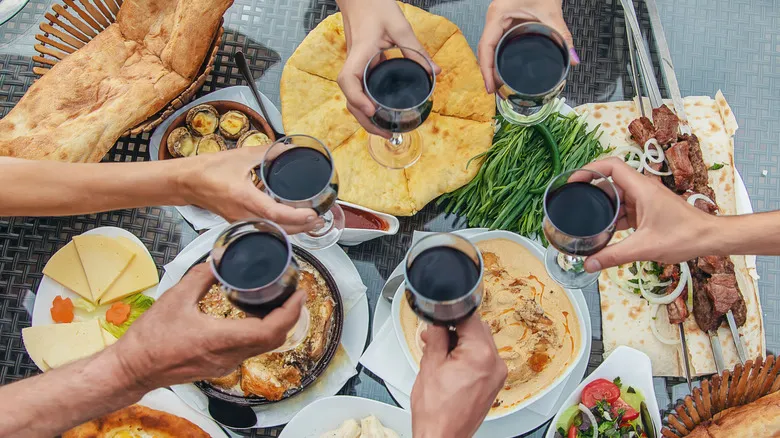
If you travel to the country of Georgia, you might find yourself welcomed to a lavish feast at someone's home or in a restaurant. These dining experiences often last for hours and feature a continuous array of delectable dishes such as khachapuri (cheese-filled bread), mtsvadi (meat skewers), and kharcho (soup with meat in a walnut sauce). No Georgian feast is complete without a generous supply of Georgian wine. However, before indulging in the wine, toasts are always a must.
Georgia boasts a rich history of wine production, which has given rise to a distinctive toasting tradition observed at most gatherings. During each feast, one individual is designated as the "tamada," or toastmaster. This person ensures that guests are well taken care of and that their glasses are filled. The tamada initiates the round of toasts, and after their speech, others at the table are also encouraged to share a toast. Common themes for toasting include family, friendship, peace, and the nation itself.
Cutting pasta is a foodie faux pas in Italy
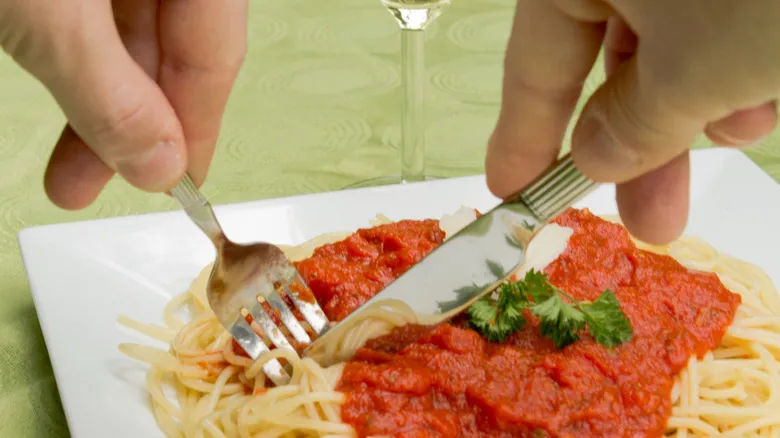
Travelers to Italy may notice that the local cuisine and dining traditions differ significantly from what is typically offered in Italian restaurants back home. For instance, some dishes labeled as "Italian" may not actually be authentic, and your Italian server might be taken aback if you request items like garlic bread or spaghetti and meatballs. Additionally, cutting your pasta with a knife and fork may elicit disapproval from those around you, as in Italy, only young children have their pasta cut into smaller pieces.
The correct way to enjoy long noodle pasta in Italy is by twirling it around your fork. You can use the edge of your plate to help secure the strands while you twirl. Once you've finished your pasta, it's perfectly acceptable to use a piece of bread to soak up any remaining sauce. This guideline also applies to other types of pasta, such as ravioli. However, if the ravioli is too large to consume in one bite, it is permissible to cut it with your fork. Another important pasta etiquette rule is that Italians never sprinkle cheese on seafood pasta, as it can overpower the delicate flavor of the fish.
Recommended

Elvis' 9 Favorite Southern Comfort Foods

Why Chocolate Mousse Was Once Referred To As Mayonnaise
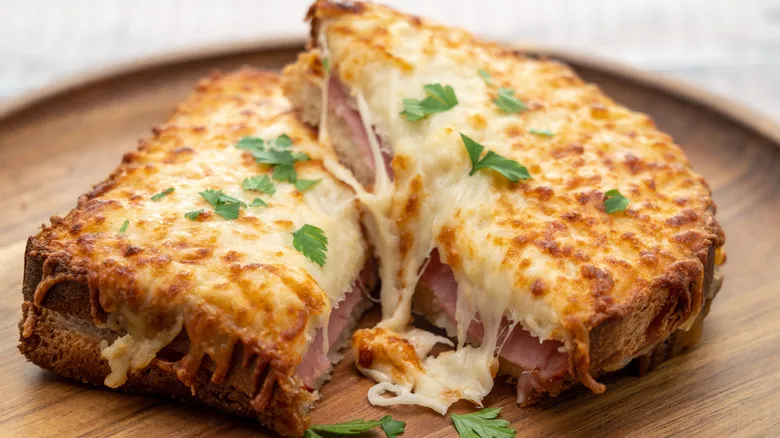
The Single Difference Between A Croque Monsieur And Croque Madame Sandwiches

The Reason Texas Chili Doesn't Have Any Beans
Next up

